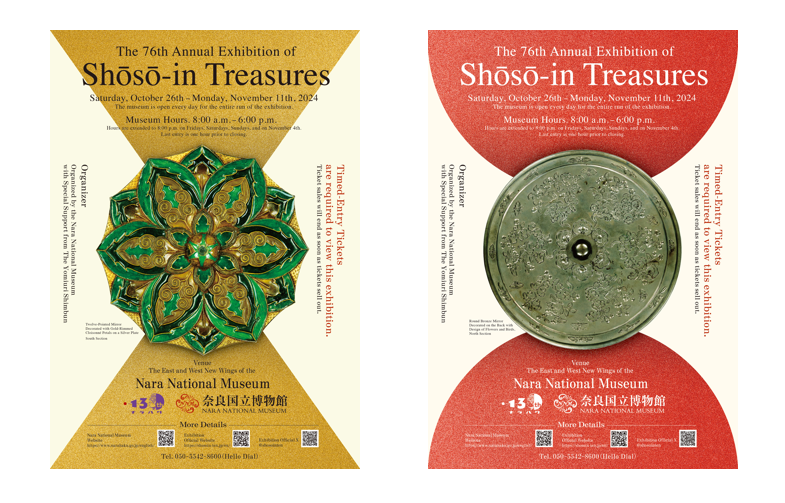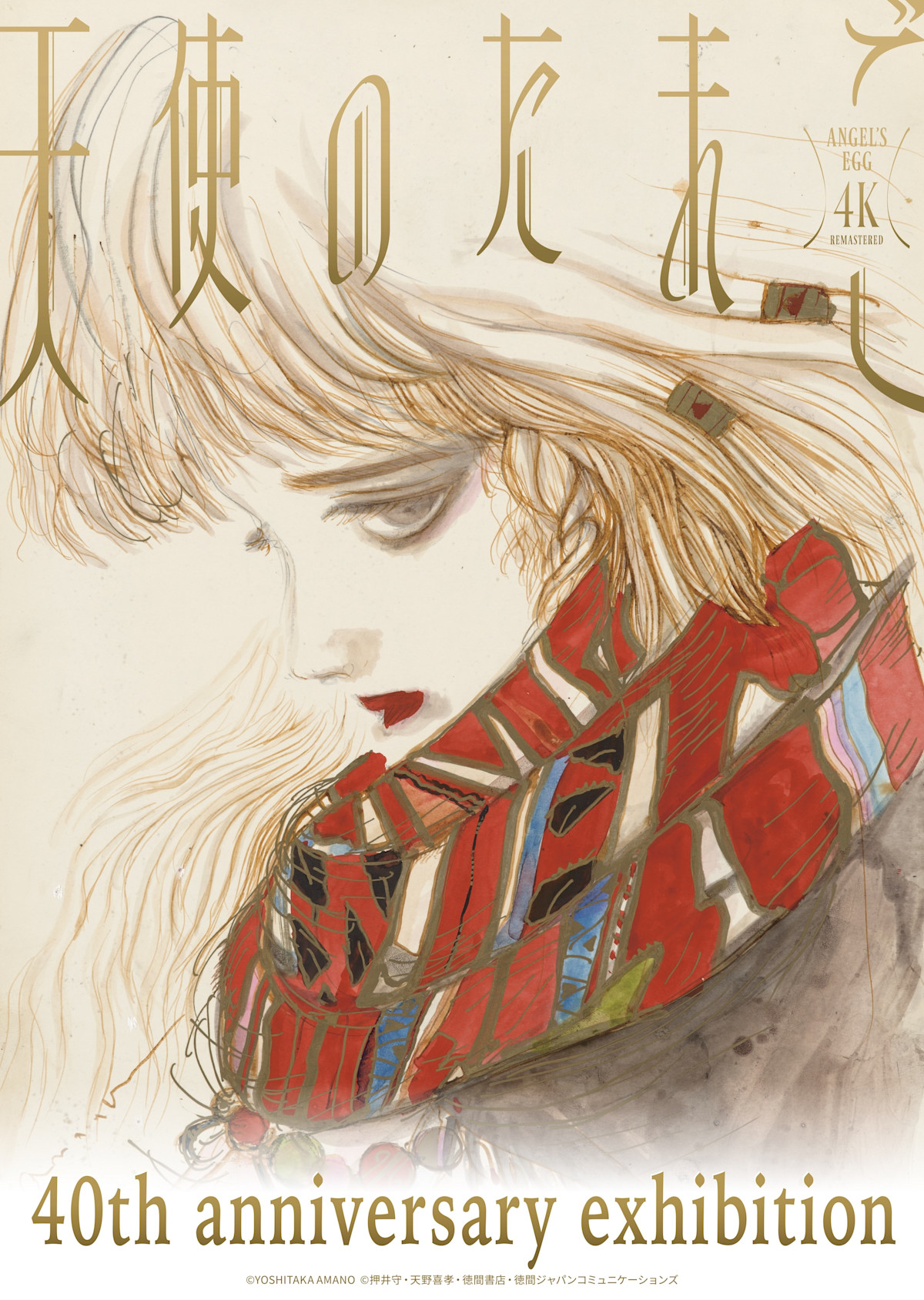NARA NATIONAL MUSEUM will hold an exhibition titled “The 76th Annual Exhibition of Shōsō-in Treasures” from October 26th (Sat) to November 11th (Mon), 2024.
The Annual Exhibition of Shōsō-in Treasures forms an important part of Nara’s autumnal resplendence. Since its implementation in 1946, it has been a celebrated tradition of the ancient capital. This year, we welcome its seventy-sixth iteration.
The beloved personal possessions of the Nara-period (710-794) sovereign Emperor Shōmu (701-756; r. 724-749) that were donated shortly after his passing lie at the core of what is referred to as the Shōsō-in treasures.The many and varied objects comprising this precious collection transmit to the present day a glimpse of the flourishing arts and culture of the Tenpyō era (mid-eighth century), creating a framework for understanding that classical period.
For centuries the Shōsō-in treasures were stored in one of Tōdaiji’s storehouses (shōsō) where they were protected and managed as important temple properties. They were carefully guarded with a special seal (chokufū) that restricted access, which accounts in part for their having been passed down to the present day as a well-preserved set.
This year, as ever, the Repository in its entirety is represented by a selection of treasures including furnishings and attire, Buddhist ritual implements and ornaments, along with written records and documents. Among these objects is the exquisite Armrest Covered in a Patterned Silk (Nishiki) of Phoenix Medallions on a Purple Ground having been used by Emperor Shōmu himself, the paramount importance of this object cannot be exaggerated.
Many treasures make magnificent use of colored glass, including personal adornments and the Shōsō-in’s only cloisonné mirror. These objects catch the eye with their delightful splendor. Finally, on display this year are reproductions that were made through the decades by the Office of the Shōsō-in, Imperial Household Agency. Close inspection of these carefully reproduced items will help viewers become familiar with the techniques used to make the Shōsō-in treasures and should thus deepen their appreciation of the originals.
Lastly, we extend our sincere gratitude to the many people and institutions that have contributed to bringing this year’s exhibition to fruition, first and foremost among them the Office of the Shōsō-in, Imperial Household Agency.
What is the Annual Exhibition of Shōsō-in Treasures?
Each year in the fall, the Imperial seal behind which the Shōsō-in Treasures are stored in the Repository at Tōdaiji Temple is opened for a short window of time for inspection. During this period, a selection of treasures is put on display to make the treasures accessible to the general public at the Annual Exhibition of Shōsō-in Treasures. The group of treasures brought out each year is selected to give a sense of the collection as a whole and to feature works that have drawn attention through recent research findings. The first exhibition was held in 1946 at what was then the Nara Imperial Household Museum. With the exception of three subsequent exhibitions in Tokyo (held in 1949, 1959, and 1981) the show has opened in Nara every year since.
What are the Shōsō-in Treasures?
While the treasures preserved through the centuries in the Shōsō-in Repository are believed to have entered the storehouse through various circumstances, the majority of them can be divided into the following three groups: 1. Those presented as offerings by Empress Kōmyō (701-760) to the Great Buddha of Tōdaiji on the twenty-first day of the sixth month in Tenpyō Shōhō 8 (756) after the forty-nine days of mourning following the passing of Emperor Shōmu (701-756; r. 724-749); 2. Various objects and implements used during ceremonies at Tōdaiji; and 3. Materials connected to the administration of Tōdaiji and its Scriptorium from the Tōdaiji Construction Bureau (Zō Tōdaiji Shi) .There are also various ritual implements that were used in ceremonies at the palace, weaponry, and instruments. The breadth and variety of the treasures suggest several threads of history and provenance interweaving the collection’s objects.
The 76th Annual Exhibition of Shōsō-in Treasures
Dates
Saturday, October 26th-Monday, November 11th, 2024
The museum is open every day for the entire run of the exhibition.
Venue
The East and West New Wings of the Nara National Museum in Nara, Japan
Hours
8:00 A.M. to 6:00 P.M., and until 8:00 P.M. on Fridays, Saturdays, Sundays, and Holidays
Last entry is sixty minutes before closing.
About This Year’s Treasures
Of the fifty-seven treasures included in this year’s exhibition , eleven (including replicas) are displayed for the first time.
There are ten treasures from the North Section, twenty-two from the Middle Section,twenty-two from the South Section, and three from the Shōgozō.
Organizer:
Nara National Museum
With Special Support from:
The Yomiuri Shimbun
Organizers and Sponsors
The exhibition has been made possible with the support of: Central Japan Railway Company; Daicel Corporation; DAIKIN INDUSTRIES, LTD.; Daiwa House Industry Co., Ltd.; INDEN YA Co., Ltd.; Iwatani Corporation; Kansai Electrical Safety Inspection Association; Kintetsu Railway Co., Ltd.; Maruichi Steel Tube Ltd.;Nakanishi Metal Works Co., Ltd.; NIPPON TELEGRAPH AND TELEPHONE WEST CORPORATION; SGC Co., Ltd.; Shionogi Healthcare Co., Ltd.; West Japan Railway Company; YAMATO NOEN CO., LTD.; with the special support of the Yomiuri Shimbun Co.; and with the cooperation of Japan Broadcasting Corporation (NHK) Nara Station; Nara Kōtsū Bus Lines Co., Ltd.; Nara Television Co., Ltd.; Nippon Kōdō Co.,Ltd.; Bukkyō Bijutsu Kyōkai (Buddhist Art Foundation); and the Yomiuri Telecasting Corporation.
Through Corporate Partnership with:
DMG MORI Co., Ltd.
Website
Nara National Museum Website
https://www.narahaku.go.jp/english/exhibition/special/202410_shosoin
Exhibition Official Website
Admission
General Admission 2,000 JPY (Late Entry: 1,500 JPY)
University and High School Students 1,500 JPY (Late Entry: 1,000 JPY)
Junior High and Elementary School Students 500 JPY (Late Entry: Free)
Free of charge entry to disabled certificate holders and an accompanying caretaker (upon presenting the certificate); preschoolers; late entry rate (junior high and elementary school students); Nara National Museum Membership card holders (for first and second entry); Sponsorship Members (Nara National Museum, Tokyo National Museum [except Silver Members], Kyushu National Museum); Seifukai Members (Kyoto National Museum); and Special Supporters.
Those benefitting from free admission do not need to purchase timed-entry tickets but are required to present their certificate or membership card upon arrival.
(Except for junior high and elementary school students and younger.)
Please note that you cannot change, cancel, or reissue your timed-entry tickets,and there are no refunds.
The Late Entry discount is available with timed-entry tickets only and applies from Monday through Thursday after 4:00 P.M. and after 5:00 P.M. on Fridays,Saturdays, Sundays, and Holidays.
Excluding those benefitting from free admission, all tickets are timed-entry and must be purchased prior to one’s arrival at the museum.
Ticket sales will end as soon as the tickets made available for each timed-entry window have been sold out.
Timed-entry tickets can be purchased the same day as one’s visit up to the start of each timed-entry window.
How to Purchase Timed-Entry Tickets
Tickets are available for purchase through the following vendors and methods:
E-Ticket (English available) https://www.e-tix.jp/shosoin-ten/en
LAWSON TICKET
Use the L-Code 59600 at Lawson or Ministop stores or through its online ticketing website.
Lawson Ticket Japanese Site: https://l-tike.com/76shosoin-ten/
Lawson Ticket English Site: https://l-tike.com/st1/76shosoin-ten-Inbound
ART EXHIBITION JAPAN
This app is only available in Japanese. It can be used on smartphones running iOS 13/Android 6.0 and over.
Museum Entry and Viewing the Exhibition
You will not be permitted to enter the museum on a day or window of time other than that designated on your ticket.
Depending on the circumstances in the galleries, you may be admitted slightly before the start of your ticket’s timed entry window or a little while after it has begun.
Because the galleries are typically at their most crowded at the start of each timed-entry window, we recommend that you plan on arriving at the museum shortly after the start of the time slot designated on your ticket.
There is no rotation of works throughout the length of the exhibition.
You may use your timed-entry Shōsō-in Exhibition ticket for admission to the Nara Buddhist Sculpture Hall and the Chinese Ritual Bronzes Gallery.
There is no parking lot available at the museum. Please refrain from visiting the museum by car.
Major Works

Twelve-Sided Mirror with a Flower in Cloisonné and Gold
(Previously exhibited : 2000)
Thin silver sheets were cut into petal shapes, fired with three colors of lead glass in the cloisonné technique, and attached to the silver base of this mirror .Thin sheets of pure gold were affixed in the spaces between the petal tips, adding another element of luxury. Only in the Shōsō-in could such an object be so wonderfully well-preserved; it is the one and only cloisonné example of its type.

Armrest Covered in a Patterned Silk (Nishiki) of Phoenix Medallions on a Purple Ground
(Previously exhibited : 2004)
This armrest is covered with a gorgeous patterned silk and is a treasured memorial object of Emperor Shōmu’s noted in the Record of the Nation’s Rare Treasures.The design composition of the imposing phoenix surrounded by grapevine scrolls is superb and the purple based color scheme is highly prestigious, befitting of an emperor’s possessions.

Dark Green Glass Fish Shaped Ornament
Light Green Glass Fish Shaped Ornament
Blue Glass Fish Shaped Ornament
Yellow Glass Fish Shaped Ornament
(Previously exhibited : 2003)
These are fish-shaped glass accessories. Rather than being cast, they were carved from lumps of colored glass. In ancient China, fish-shaped tags were used as permits to allow one to pass into the palace; it is thought that elite Japanese wore fish-shaped accessories on their waist sashes in reference to this history.
Publicity Images

If you wish to use the main visual, you can download it from the following URL
address. (No need for application)
https://www.narahaku.go.jp/news/20241007_11996
If you wish to use the image(s) of Shōsō-in treasures as depicted in the Press Release,you will need to apply for prior permission. Please apply by contacting the email address below.
The 76 th Annual Exhibition of Shōsō in Treasures Public Relations Office (Muse PR Inc) Contact Oyama Yoshihiko and Fujimaki Kaori EMAIL info@musepr.co.jp
Press Release (Japanese only) https://www.artpr.jp/prs/2024shosoin








